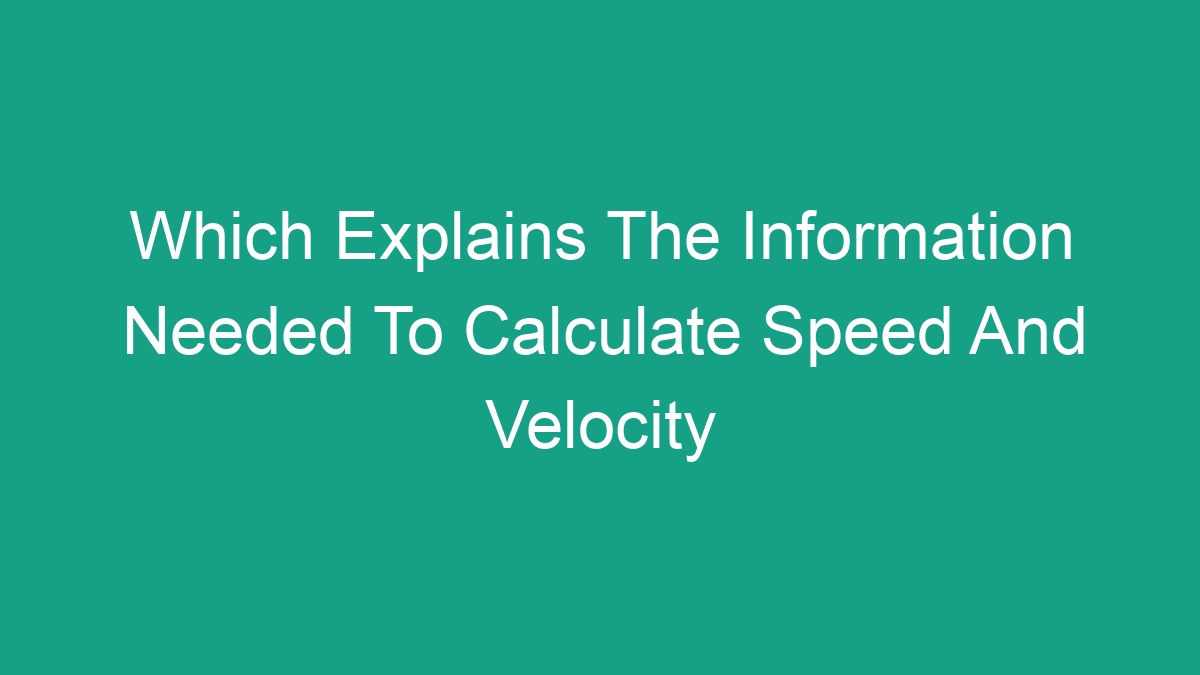
Introduction
Speed and velocity are two fundamental concepts in physics that describe how fast an object is moving and in what direction. While these terms are often used interchangeably in everyday language, they have distinct meanings in the field of physics. In this article, we will delve into the differences between speed and velocity, as well as the information needed to calculate them.
Defining Speed and Velocity
Speed is a scalar quantity that simply represents how fast an object is moving. It is calculated by dividing the distance traveled by the time it took to travel that distance. The formula for speed is:
\[ \text{Speed} = \frac{\text{Distance}}{\text{Time}} \]
Speed is measured in units such as meters per second (m/s), miles per hour (mph), or kilometers per hour (km/h).
Velocity, on the other hand, is a vector quantity that not only describes how fast an object is moving but also in what direction it is moving. It includes both the speed and the direction of motion. The formula for velocity is:
\[ \text{Velocity} = \frac{\text{Displacement}}{\text{Time}} \]
Velocity is also measured in units like meters per second (m/s), miles per hour (mph), or kilometers per hour (km/h), but it includes a direction component as well.
Information Needed to Calculate Speed and Velocity
In order to calculate speed and velocity, certain pieces of information are required. These include distance, displacement, and time. Let’s explore each of these components in more detail.
Distance: The distance traveled by an object is the total path length it has covered. This can be measured in units such as meters, kilometers, miles, etc. To calculate speed, the distance traveled by the object is divided by the time it took to cover that distance.
Displacement: Displacement is a vector quantity that refers to the change in position of an object. It is the straight-line distance and direction between the starting point and ending point of the object’s motion. Displacement can be positive, negative, or zero, depending on the direction of the motion. To calculate velocity, the displacement of the object is divided by the time it took to cover that displacement.
Time: Time is simply the duration of the motion, typically measured in seconds, minutes, hours, etc. It is an essential component in the calculation of both speed and velocity.
Calculating Speed and Velocity
To calculate speed, the formula mentioned earlier is used:
\[ \text{Speed} = \frac{\text{Distance}}{\text{Time}} \]
For example, if a car travels 100 miles in 2 hours, its speed can be calculated as:
\[ \text{Speed} = \frac{100 \text{ miles}}{2 \text{ hours}} = 50 \text{ mph} \]
Calculating velocity involves using the formula:
\[ \text{Velocity} = \frac{\text{Displacement}}{\text{Time}} \]
For instance, if a person walks 20 meters north in 10 seconds, their velocity can be calculated as:
\[ \text{Velocity} = \frac{20 \text{ m north}}{10 \text{ s}} = 2 \text{ m/s north} \]
Understanding the Difference
It’s important to note that while speed and velocity are closely related, they are not the same. The key difference lies in the inclusion of direction in velocity, whereas speed only considers the rate of motion. This means that two objects can have the same speed but different velocities if they are moving in different directions.
For example, if a car is traveling at a constant speed of 60 mph along a straight road, its velocity is constant as well. However, if the car then makes a turn, its direction changes, and so does its velocity, even though its speed remains the same.
Understanding this distinction is crucial in many real-world scenarios, such as navigation, sports, and engineering, where both speed and direction play a vital role.
Practical Applications
The concepts of speed and velocity have numerous practical applications in various fields. Here are a few examples:
Transportation: Speed and velocity calculations are essential for designing efficient transportation systems, optimizing travel routes, and ensuring safety on roads, railways, and airways.
Sports: In athletics, the measurement of speed and velocity is crucial for analyzing an athlete’s performance, understanding projectile motion in sports like basketball and baseball, and designing racing tracks.
Physics and Engineering: Speed and velocity are fundamental concepts in physics and engineering. They are used in the design of machinery, vehicles, and structures to ensure they perform optimally and safely.
Navigation: GPS and navigation systems rely on speed and velocity calculations to provide accurate location and direction information to users.
Conclusion
In conclusion, speed and velocity are fundamental concepts in physics that describe the motion of objects. While speed represents how fast an object is moving, velocity includes both the speed and direction of motion. To calculate speed and velocity, the key components needed are distance, displacement, and time. Understanding the difference between these two concepts is crucial for a wide range of practical applications in transportation, sports, physics, and engineering. By grasping the fundamentals of speed and velocity, we can better comprehend and analyze the motion of objects in our everyday lives.



